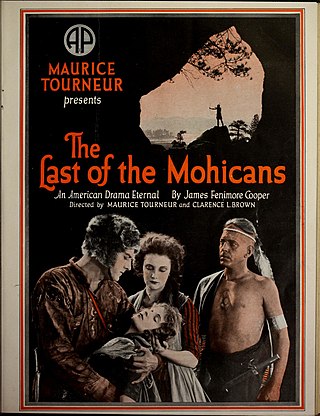
The Last of the Mohicans is a 1920 American silent adventure drama film written by Robert A. Dillon, adapted from James Fenimore Cooper's 1826 novel of the same name. Clarence Brown and Maurice Tourneur co-directed the film. It is a story of two English sisters meeting danger on the frontier of the American colonies, in and around the fort commanded by their father. The adventure film stars Wallace Beery, Barbara Bedford, Lillian Hall, Alan Roscoe and Boris Karloff in one of his earliest silent film roles. Barbara Bedford later married her co-star in the film, Alan Roscoe in real life. The production was shot near Big Bear Lake and in Yosemite Valley.
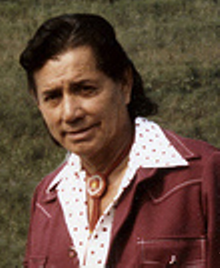
Jay Silverheels was an Indigenous Canadian actor and athlete. He was well known for his role as Tonto, the Native American companion of the Lone Ranger in the American Western television series The Lone Ranger.
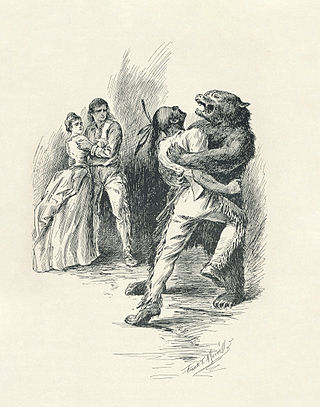
The Last of the Mohicans: A Narrative of 1757 is a historical romance novel written by James Fenimore Cooper in 1826. It is the second book of the Leatherstocking Tales pentalogy and the best known to contemporary audiences. The Pathfinder, published 14 years later in 1840, is its sequel; its prequel, The Deerslayer, was published a year after The Pathfinder. The Last of the Mohicans is set in 1757, during the French and Indian War, when France and Great Britain battled for control of North America. During this war, both the French and the British used Native American allies, but the French were particularly dependent, as they were outnumbered in the Northeast frontier areas by the British. Specifically, the events of the novel are set immediately before, during, and after the Siege of Fort William Henry.

Uncas was a sachem of the Mohegans who made the Mohegans the leading regional Indian tribe in lower Connecticut, through his alliance with the New England colonists against other Indian tribes.

Magua is a fictional character and the main antagonist in the 1826 novel The Last of the Mohicans by James Fenimore Cooper. This historical novel is set at the time of the French and Indian War. A Huron Indian chief, he is also known by the French alias "Le Renard Subtil".

The Leatherstocking Tales is a series of five novels by American writer James Fenimore Cooper, set in the eighteenth-century era of development in the primarily former Iroquois areas in central New York. Each novel features Natty Bumppo, a frontiersman known to European-American settlers as "Leatherstocking", "The Pathfinder", and "the trapper". Native Americans call him "Deerslayer", "La Longue Carabine", and "Hawkeye".

Chingachgook is a fictional character in four of James Fenimore Cooper's five Leatherstocking Tales, including his 1826 novel The Last of the Mohicans. Chingachgook was a lone Mohican chief and companion of the series' hero, Natty Bumppo. In The Deerslayer, Chingachgook married Wah-ta-Wah, who had a son with him named Uncas, but died while she was still young. Uncas, who was at his birth "last of the Mohicans", grew to manhood but was killed in a battle with the Huron warrior Magua. Chingachgook died as an old man in the novel The Pioneers, which makes him the actual "last of the Mohicans," having outlived his son.
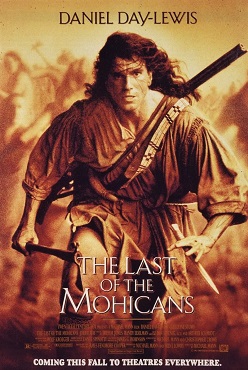
The Last of the Mohicans is a 1992 American historical action film directed by Michael Mann, who co-wrote the screenplay with Christopher Crowe, based on the 1826 novel of the same name by James Fenimore Cooper. The film is set in 1757 during the French and Indian War. It stars Daniel Day-Lewis, Madeleine Stowe, and Jodhi May.

Sam Katzman was an American film producer and director. Katzman's specialty was producing low-budget genre films, including serials, which had disproportionately high returns for the studios and his financial backers.

The Deerslayer, or The First War-Path (1841) was James Fenimore Cooper's last novel in his Leatherstocking Tales. Its 1740–1745 time period makes it the first installment chronologically and in the lifetime of the hero of the Leatherstocking tales, Natty Bumppo. The novel's setting on Otsego Lake in central, upstate New York, is the same as that of The Pioneers, the first of the Leatherstocking Tales to be published (1823). The Deerslayer is considered to be the prequel to the rest of the series. Fenimore Cooper begins his work by relating the astonishing advance of civilization in New York State, which is the setting of four of his five Leatherstocking Tales.

The Last of the Mohicans is a 1936 American historical western adventure film directed by George B. Seitz and starring Randolph Scott, Binnie Barnes and Henry Wilcoxon. The screenplay by Philip Dunne was based on the 1826 novel of the same name by James Fenimore Cooper. It was produced by Edward Small and distributed by United Artists.
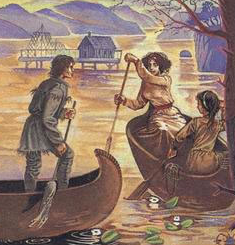
Nathaniel "Natty" Bumppo is a fictional character and the protagonist of James Fenimore Cooper's pentalogy of novels known as the Leatherstocking Tales.

Hawkeye is a television series, airing in syndication for one season during 1994–1995, and produced by Stephen J. Cannell. The series was filmed in North Vancouver and Vancouver, British Columbia, Canada.
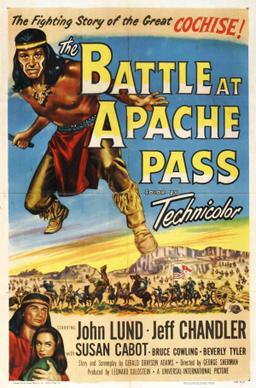
The Battle at Apache Pass is a 1952 American Western film directed by George Sherman. The stars are John Lund as United States Army Maj. Colton and Jeff Chandler repeating the role of Apache chief Cochise, whom he had played two years earlier in 20th Century Fox's Broken Arrow. Jay Silverheels also reprised his role of Geronimo from the same film.

War Arrow is a 1954 American Technicolor Western film directed by George Sherman and starring Maureen O'Hara, Jeff Chandler and John McIntire. Filmed by Universal Pictures and based on the Seminole Scouts, the film was shot in Agoura, California.
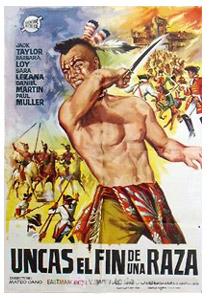
Fall of the Mohicans is a 1965 Spanish-Italian historical western adventure film directed by Mateo Cano and starring Jack Taylor, Paul Muller and Sara Lezana. The film is based on James Fenimore Cooper's 1826 novel The Last of the Mohicans, but made in the style of a Spaghetti Western. It was shot on location in the Tabernas Desert of Almería Another adaptation of the story The Last Tomahawk was released the same year by Germany's Constantin Film.
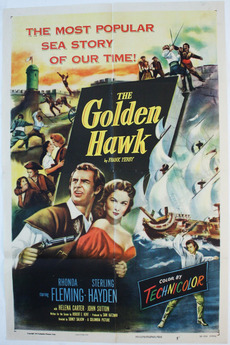
The Golden Hawk is a 1952 American historical adventure film directed by Sidney Salkow and starring Rhonda Fleming, Sterling Hayden and John Sutton. It is based on the 1948 novel of the same name by Frank Yerby.

Last of the Redskins is a 1947 American Western film directed by George Sherman and starring Joh Hall and Michael O'Shea. The film was shot in Vitacolor but released in Cinecolor.

The Iroquois Trail is a 1950 American Western film directed by Phil Karlson starring George Montgomery and Brenda Marshall. It is set during the French-Indian War. It is an adaptation of James Fenimore Cooper's 1826 work The Last of the Mohicans, with significant alterations. As with the book, one of the major plot lines is based on the siege of Fort William Henry and the subsequent massacre.
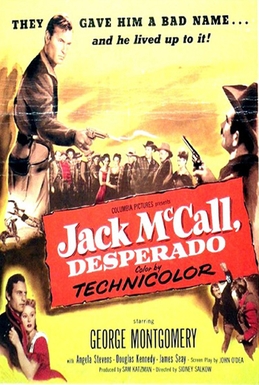
Jack McCall, Desperado is a 1953 American Western film directed by Sidney Salkow and starring George Montgomery. It portrays the historical shooting of Wild Bill Hickok by Jack McCall in 1876.



















